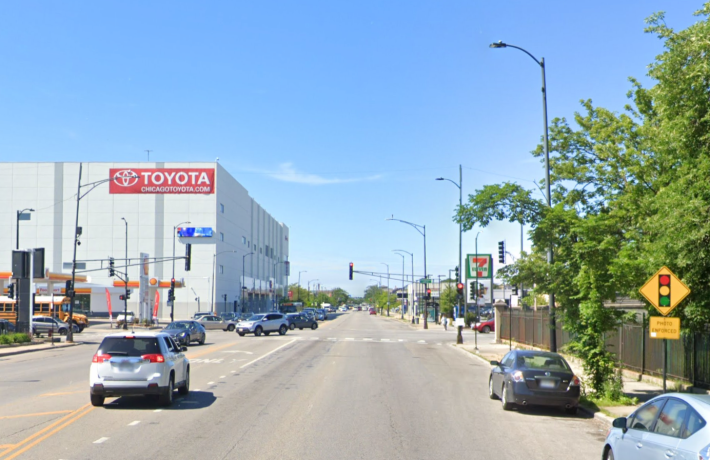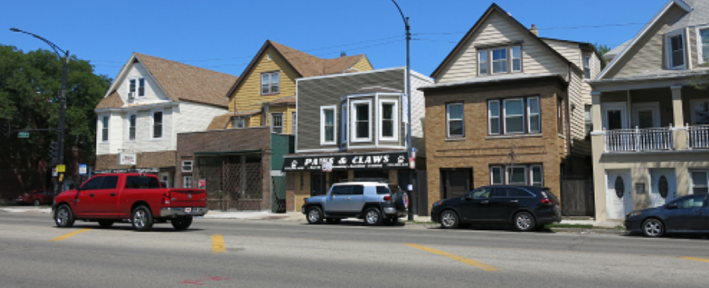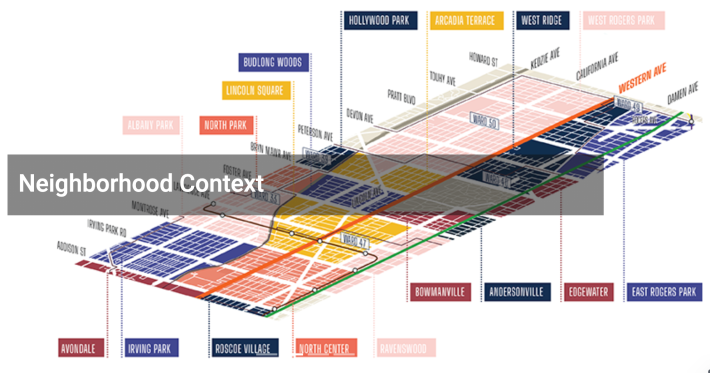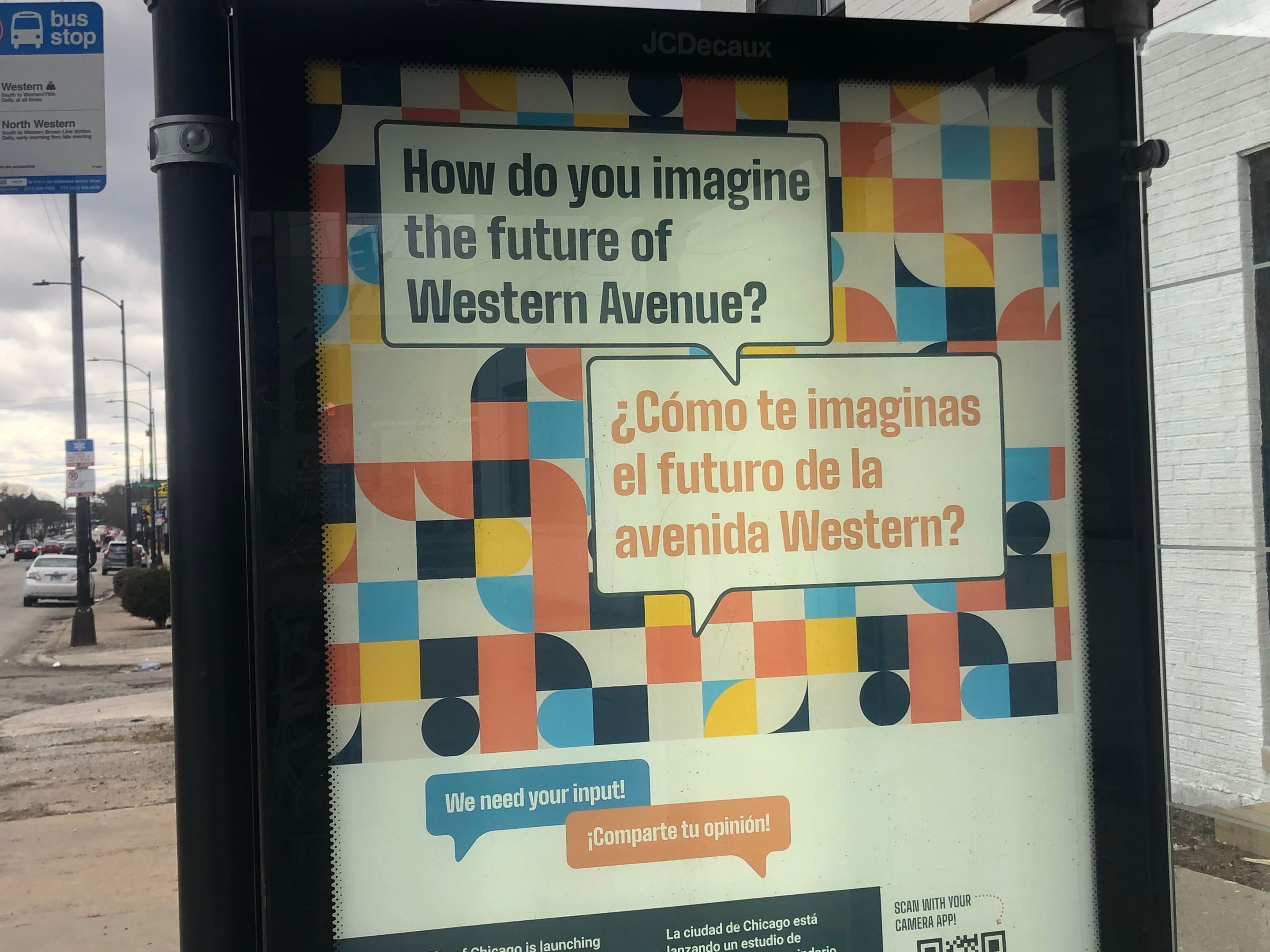If you bring up Western Avenue to a group of sustainable transportation advocates, you’ll get lots of opinions. Currently Western is a very auto oriented street, generally five lanes with high traffic volumes and/or speeds, which makes it unpleasant for those walking along and across it. Three different stretches of Western are listed as collision-prone segments on the city’s Vision Zero High-Crash Corridor report. Western Avenue is also home to the high-ridership CTA bus lines 49 Western, X49 Western Express, and 49B North Western, which currently get stuck in traffic jams created by solo drivers.

The city of Chicago is looking to revamp the five mile section of Western between Addison and Howard streets. This joint project between the Chicago Department of Transportation and the Department of Planning and Development seeks to involve residents, visitors, and other stakeholders of this northern portion of Western Avenue in creating a vision of Western that is equitable and long-term. To that end, the project will examine the potential to increase density, promote more diverse land uses, improve how development along Western relates to nearby residential areas, and enhance pedestrian safety. The community-led planning process will help determine future land use and zoning recommendations, design guidelines, and potential public right-of-way improvements. The roadmap that will be developed is the first of many steps towards creating a better Western Avenue.

Community engagement started back in December 2020 when residents within a half mile of Western were sent postcards informing them of the study and an initial online survey. Posters about the study were also hung at bus shelters along Western and placard ads were also displayed inside buses. City representatives walked the corridor and talked with local businesses and organizations about the study and asked to leave postcards and flyers about the project.
Lastly, a youth council was formed in collaboration with local schools and Territory, a nonprofit that offers young people opportunities to get involved with urban design, public art, and community planning. The youth council identified more opportunities to reach young people beyond social media and other online approaches. An Internet survey was available throughout the month of January. In total, 1,800 people took the online survey. According to the project website, an analysis of the survey will be provided at the next community meeting, which will be announced in the near future.

I reached out to DPD to find out more about the community engagement process for the study. I spoke with urban planner Katharyn Hurd and spokesperson Kevin Bargnes.
Courtney Cobbs: I acknowledge I haven’t lived in Chicago very long, compared to those who have been born and raised here. I’ve seen different initiatives that seek community input. What’s different about this project?
Katharyn Hurd: For starters, CDOT and DPD are co-leading this project. Typically only one agency will lead and another agency will be a stakeholder. By working together on this vision, we expect this coordination to lend itself to a faster timeline for implementation. Second, the Lightfoot administration has an appetite for trying new types of engagement. Thirdly, COVID has allowed us room to be creative in how we can engage people. People don’t have to travel to a meeting, they can just log in or phone in to be a part of it. We want to hear from people who typically don’t show up to meetings.
CC: You mentioned implementation. Can you explain?
KH: The study is primarily about articulating a vision. It’s not the same as a specific streetscape project that will have a specific construction project come out of it. The Western Avenue document will have a series of recommendations. One of those recommendations will be around urban design guidelines that will apply to private development. We want to have guidance available so that developers have an idea of what the city and the community are looking for. The recommendations can vary; We may identify public realm improvements [think bump-outs and pedestrian islands] or bus service improvements. The recommendations won’t just happen because of the study though. We identify what needs to be improved, how much it will cost, funding sources, partners, enabling projects, etc. This plan will guide us in terms of priorities and order of operations so that we can take action now with the knowledge these things take time.

CC: Say a developer approaches the city with a proposal along this corridor and they offer something that is different than what the community has articulated what they wanted. How would this plan come into play?
KH: It depends on what the community is saying they want. If we’re talking about density, height, or uses, those things can be controlled with zoning. So, perhaps some of the recommendations would be to make changes to zoning along the corridor in order to disallow certain uses and make things easier for the developments we do want to see. On top of zoning, we’ll have design guidelines. We already have neighborhood design guidelines and the Western Avenue guidelines will be laid on top of them. If a development needs to come before DPD, we can point to this plan and say, “This is what the community wants.” That provides a bit more leverage in shaping what’s constructed. In the end, we want to put the community’s desires out there so that developers can understand what’s wanted. Developers don’t want to fight with the community; it doesn’t benefit their bottom line.
KB: Yeah, projects of a certain size and scope that go through that Planned Development review process with DPD are always referring to plans and studies developed within the neighborhood in question. Those studies are a key part in how DPD can say, “We want you to look at these plans developed by the community and reconsider.”

CC: So, is there a difference between plans privately commissioned and those commissioned by the city?
KH: So, for example the Lincoln Square Master Plan was created in 2019 and commissioned by the Lincoln Square Chamber of Commerce and their [Special Service Area.] That plan was not adopted by the Planning Commission but it doesn’t mean we don’t look at it or find it valuable. It was not vetted by the city. There are aspects of that plan that the city may not find feasible – for example CDOT may look at the transportation plan and find it infeasible. DPD may not agree with some elements. I don’t know if that’s the case with this particular plan, but in general plans happen and we don’t want to discourage other groups from planning. We believe people know their communities well. To the degree people can involve us makes it easier for city agencies to buy into those plans. However, just because it’s not adopted as an official city plan doesn’t mean it doesn’t matter. DPD talks about it and tries to take whatever is valuable within it.
KB: Yeah, so it’s that action-the adoption by the Planning Commission, that gives DPD leverage in holding developers’ feet to the fire regarding recommendations within the plan. It’s an important step if a plan is to become truly actionable by the city.
CC: Ah. Thank you for clearing that up. I’d love to know about future community engagement events regarding the Western Avenue Corridor study.
KH: We are far from done. We have finished up the first phase of three phases. We have one big public event for every phase. The first public meeting on January 27th was our kickoff meeting. You can watch a replay on the community engagement section of the project website. The first phase identified some of the issues and now we’ll be testing concepts and strategies to address those issues and asking the community to evaluate them. This next meeting will be more interactive. The final public event will be towards the end of the process which will be us saying, “We heard from you what the issues are, here is what we heard about your preferences on how to address those issues, and this is a set of recommendations that will be in this draft plan going to the Planning Commission.” Look out for that second event late Spring and the final event will be mid-Summer.
KB: There will be plenty of opportunities for public input in each phase, particularly the final one regarding the recommendations going to the Planning Commission for adoption.
Note: If you’re unfamiliar with what public input regarding recommendations for the city look like, consider the city’s new equitable transit oriented development plan. There was a period in which the city was seeking public comment on the plan.
KH: We have a goal to sustain high levels of community engagement during each phase. We also want to promote buy-in for the plan. We will need partners that are invested and believe in the plan who will help us implement the plan. I can’t say when that next survey is coming out but it is in the works. We’re also planning social media content. We send digital toolkits to groups we work with- chambers of commerce, aldermen’s offices, community groups, and anyone who wants information from us to spread out to their networks. We have a project website and there’s an email address where people can send questions.
CC: Will new mailers or flyers be rolled out for the additional phases?
KB: We currently have bus ads that will stay up during the remainder of the process. I’m not sure if we’ll be able to do another mailer. We have an extensive email list and we also utilize alder’s mailing lists to share information.
CC: How are you measuring engagement? How are you measuring success?
KH: The survey is the easiest. We conduct analysis in terms of who is responding and we compare that to the demographics of the area. We know there are certain people we’re reaching and certain people we’re not. We sent out 15,000 postcards and a number of people indicated they found out about the survey through the postcards. That helps us understand how people are finding things so that we know what works in the future and can course correct. We’re working with community groups and chambers of commerce to have more targeted outreach. Our focus groups are also helpful to hear from a diverse group of people.
I later reached out to the planning department to ask how the Western Avenue study fits into We Will Chicago, a three year city-wide planning initiative. "Like all current City planning efforts, the Western Avenue study will help inform the research, engagement, and planning activities for We Will over the next two years, specifically its components related to transportation, infrastructure, land use, and urban design," responded spokesperson Kevin Bargnes. "The Western Avenue study may also serve as a model for future planning efforts in other Chicago community areas with similar issues."
If you'd like to get involved and add your voice to reimagining Western Avenue, check out the project website here.





